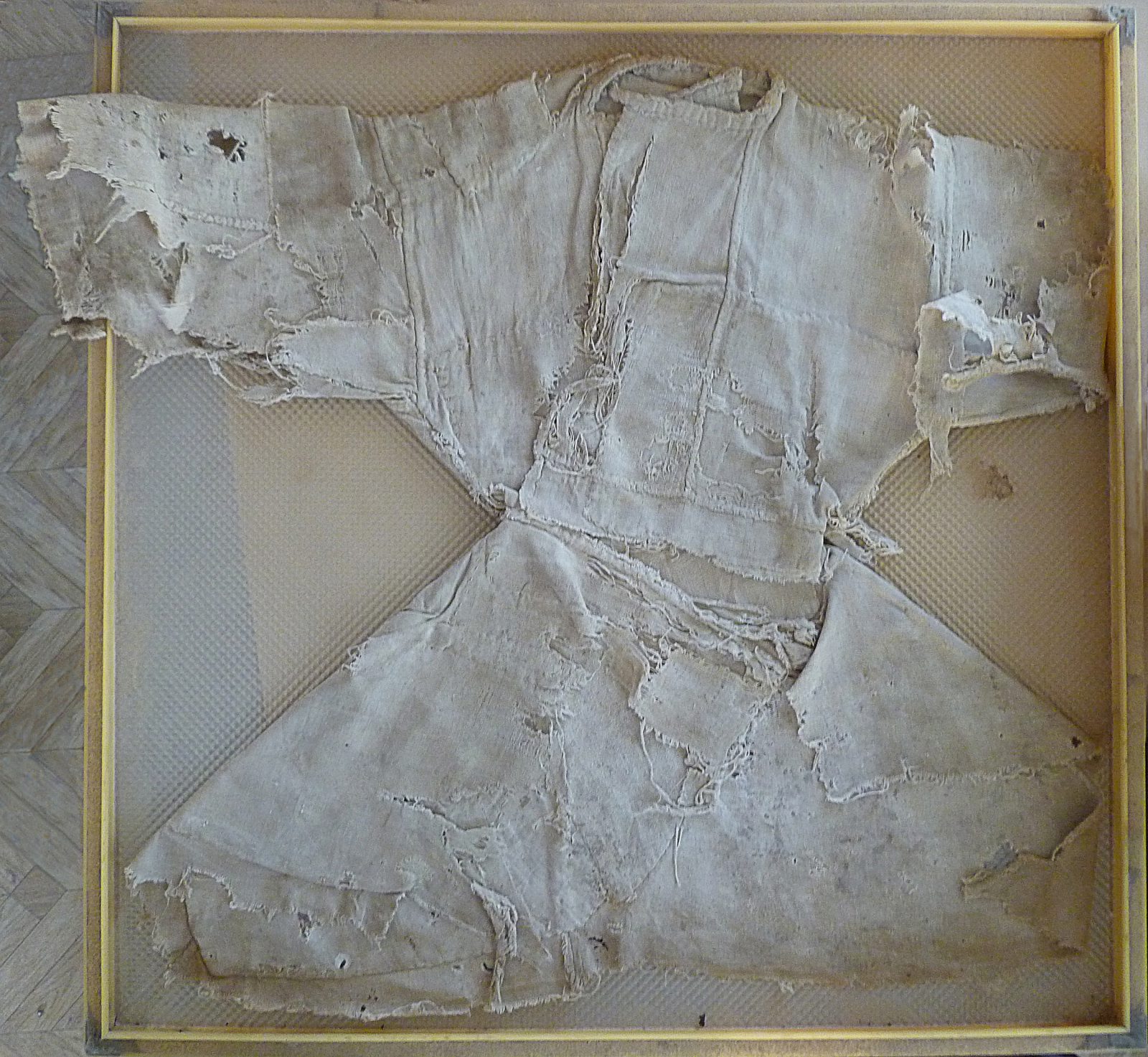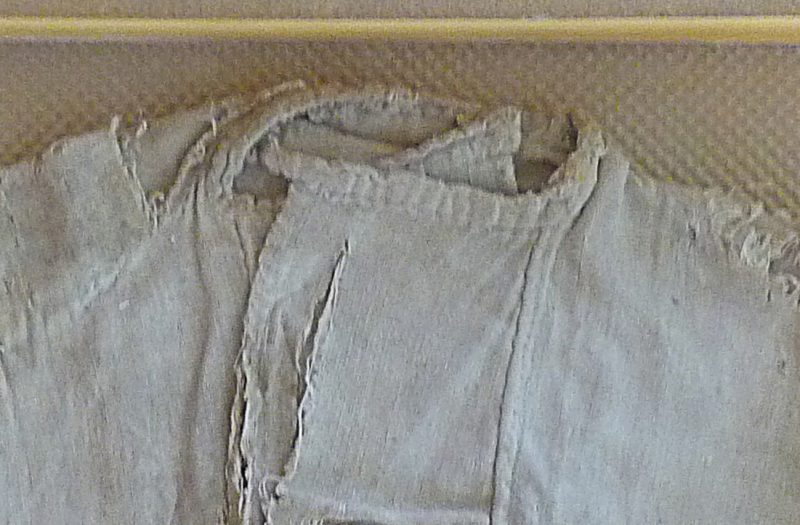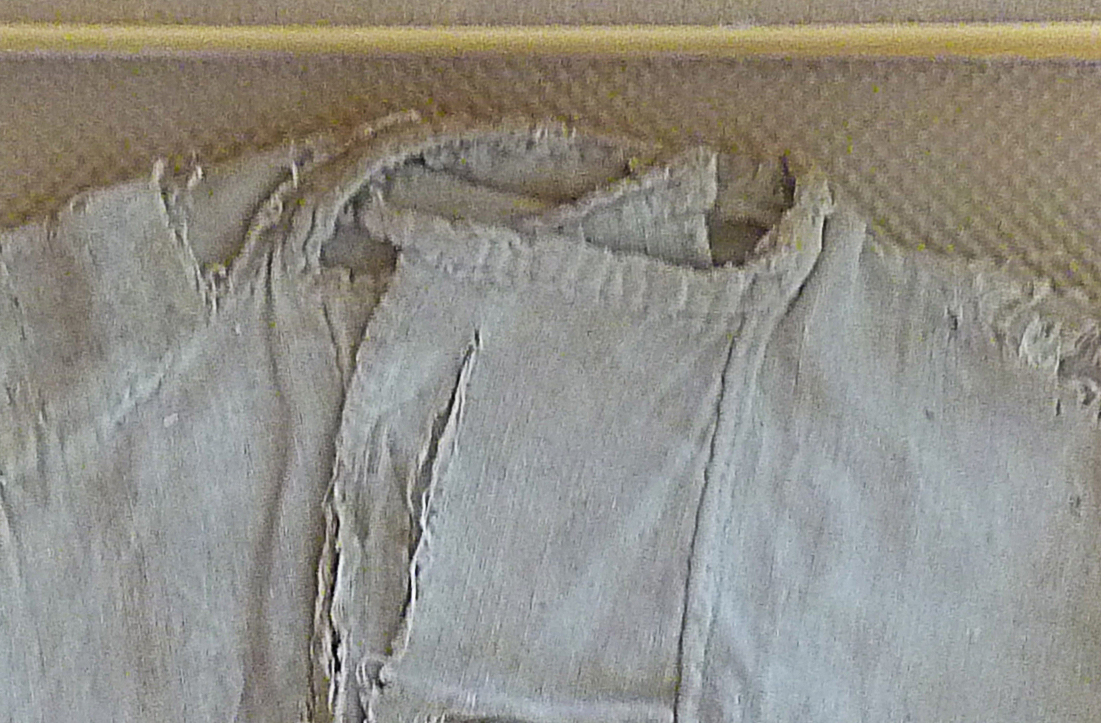
Child’s Kaftan from Sanjar-Shah
Child’s Kaftan Found during Excavations of Citadel of Sanjar-Shah
Tajikistan , 7th–8th century CE
Undyed cotton; H. (lower hem to neckline) 55 × W. (shoulder-to-shoulder) 45 cm.
Rudaki State Museum, Panjikent, Tajikistan
Photograph © Judith A. Lerner
This cotton kaftan, found in 2009 in northwestern Tajikistan, is the only one to date excavated intact from Sogdiana. It was discovered at the 7th–8th-century citadel site of Sanjar-Shah, at the edge of the village of Sudzhina, overlooking the Zerafshan River. Made for a six- or seven-year-old child, the tailored bodice would have fit snuggly around the child’s upper body, with its sleeves reaching to the wrists. The attached, flared skirting would have fallen to the child’s knees. The front panels—with its frogging closures still intact—overlap, one over the other. The rectangular shape of the front panels allows the kaftan to be worn in a number of ways: buttoned to the neck, one lapel pulled open, or two lapels pulled open to form a V-shaped neckline. This versatility in styling is the hallmark of the kaftan design; Figs. 1 and 2.
Proof of the kaftan’s identification can be found in contemporaneous wall paintings excavated at the city of Panjikent , only 7.5 miles (12 km) to the west of Sanjar-Shah. These paintings depict Panjikenters dressed in elaborately patterned kaftansSogdian Fashion Learn more about Sogdian fashion that make this child’s garment seem rather ordinary. However, its secure archaeological provenance and its nearly intact condition elevate the kaftan to quite a sensational find, as archaeologically excavated textile remains from Sogdiana are rare.
The excavators of Sanjar-Shah found the child’s kaftan on the floor of Room 9 of the Sanjar-Shah citadel. Considering this location, it was likely some child’s everyday garment. Woven from undyed cotton in a plain (or tabby) weave, it is the simplest of weaving structures. Contrary to many ideas of premodern dress, it is important to note that the kaftan’s lack of embellishment does not necessarily relegate it to a lower social stratum. An undecorated cotton kaftan provides its wearer—especially a child—with a practical, versatile and breathable garment.
by Betty Hensellek
Sh. Kurbanov and A. Teplyakova, “Textile Objects from the Citadel of Sanjar Shah,” Bulletin of the Miho Museum 15 (2014): 167–77. The Sanjar-Shah excavation team, headed by Sharofuddin Kurbanov, Alexey Savchenko and Michael Shenkar, post their excavation reports online annually. See the East Sogdian Archaeological Expedition, Sharofuddin Kurbanov, Abdurauf Rahim Razzakov, and Michael Shenkar, “ Sanjar Shah, Tadschikistan: Archaeological Excavation of an Ancient Sogdian Site.” Accessed November 22, 2017. http://www.exploration-eurasia.com/inhalt_english/frameset_projekt_5.html.
The largest textile assemblage from Sogdiana proper comes from Mount Mugh, which was excavated in the 1930s; these textiles, however, are only fragments; see I. B. Bentovich, “Nakhodki na gore Mug: Sobraniye gosudarstvennogo Ermitazha” Находки на горе Муг: Собрание государственного Эрмитажа [Finds at Mount Mugh: Materials in the State Hermitage], Materialy i issledоvaniia po Arkheologii SSSR 66 (1958): 358–83. A number of kaftans and other garments attributed to Sogdiana continue to be available on the art market, but these attributions are based only on comparison of woven motifs, many of which are connected to a fictitious Sogdian weaving workshop. For information on a mistranslation at the root of this issue, now known as the “Zandaniji problem,” see Nicholas Sims-Williams and Geoffrey Khan, “Zandanījī Misidentified,” Bulletin of the Asia Institute 22 (2008 [2012]): 207–13; and Zvezdana Dode, “‘Zandanījī Silk’: The Story of a Myth,” The Silk Road 14 (2016): 213–22, available online as a PDF at http://www.silkroadfoundation.org/newsletter/vol14/Dode_SR14_2016_213_222.pdf.
The find location is described as an unlabeled corridor; see Sh. Kurbanov and A. Teplyakova, “Textile Objects from the Citadel of Sanjar-Shah,” Bulletin of the Miho Museum 15 (2014): 168. However, in the main excavation reports it was plotted more precisely as in Room 9. See East Sogdian Archaeological Expedition, Sharofuddin Kurbanov, Abdurauf Rahim Razzakov, and Michael Shenkar, “Excavations at Sanjar Shah (Sujina, Northern Tajikistan), 17 August–31 October 2009” (2017, for the 2009 season) online at http://www.exploration-eurasia.com/inhalt/projekt_5.htm-2009



